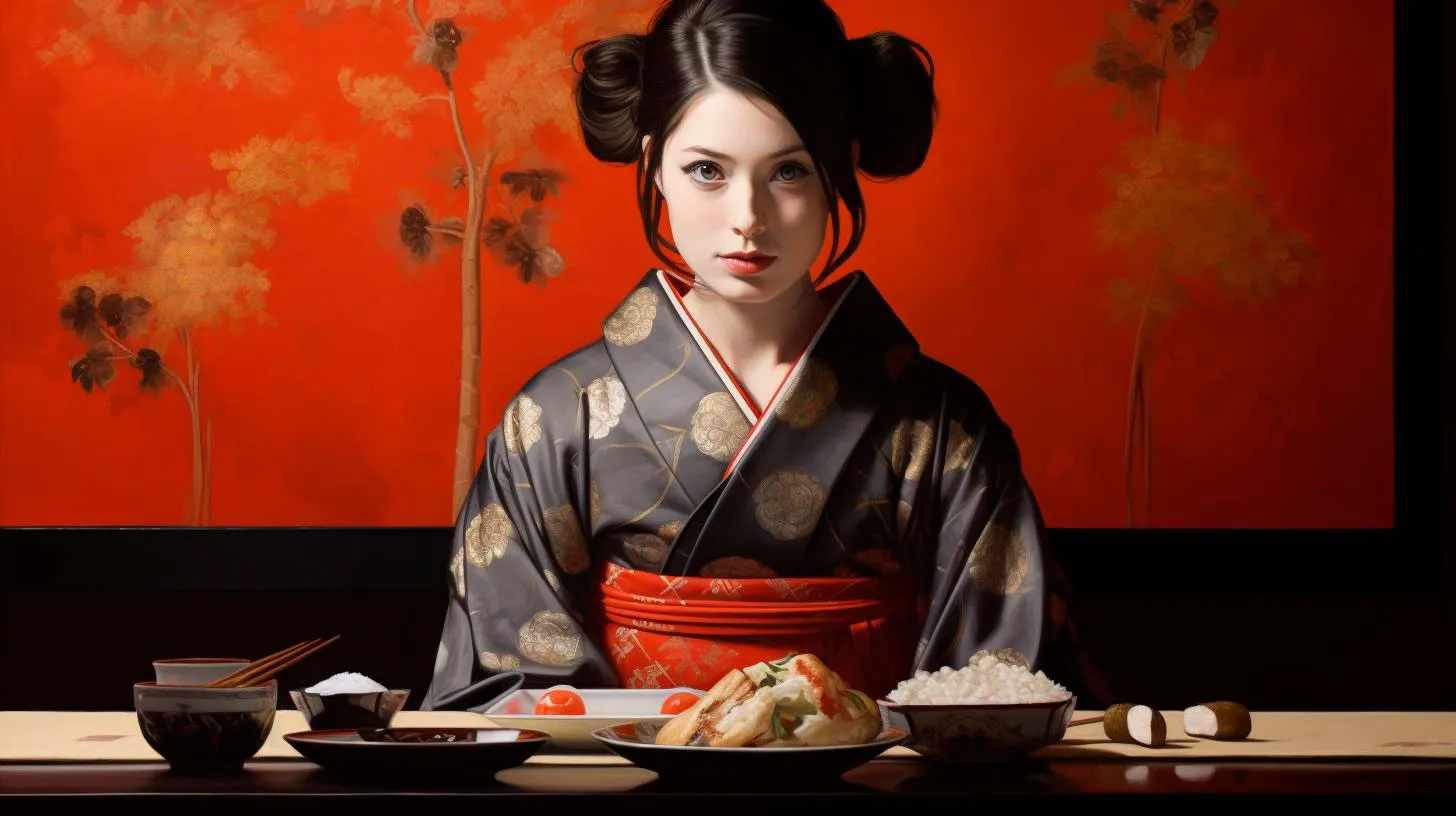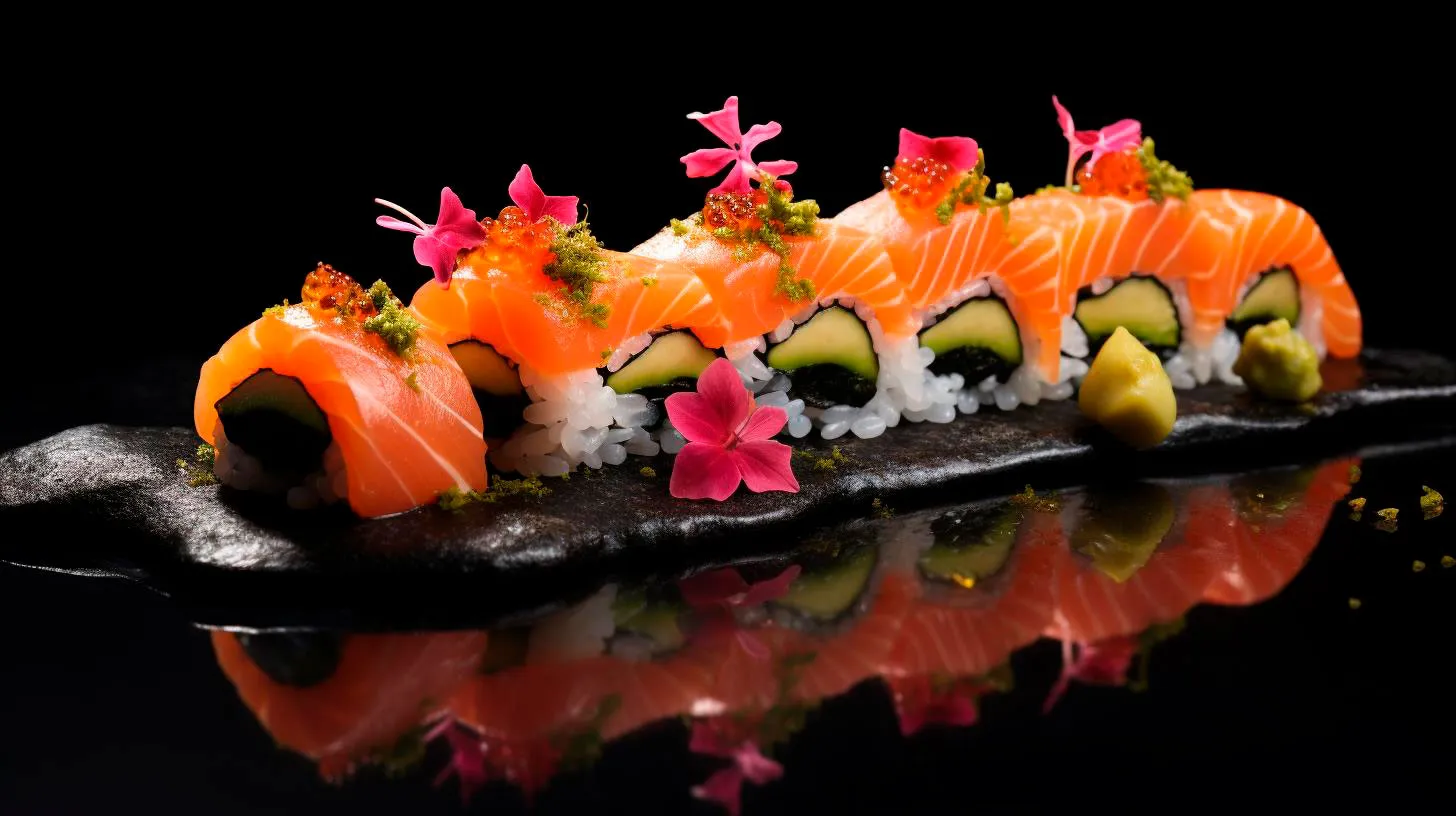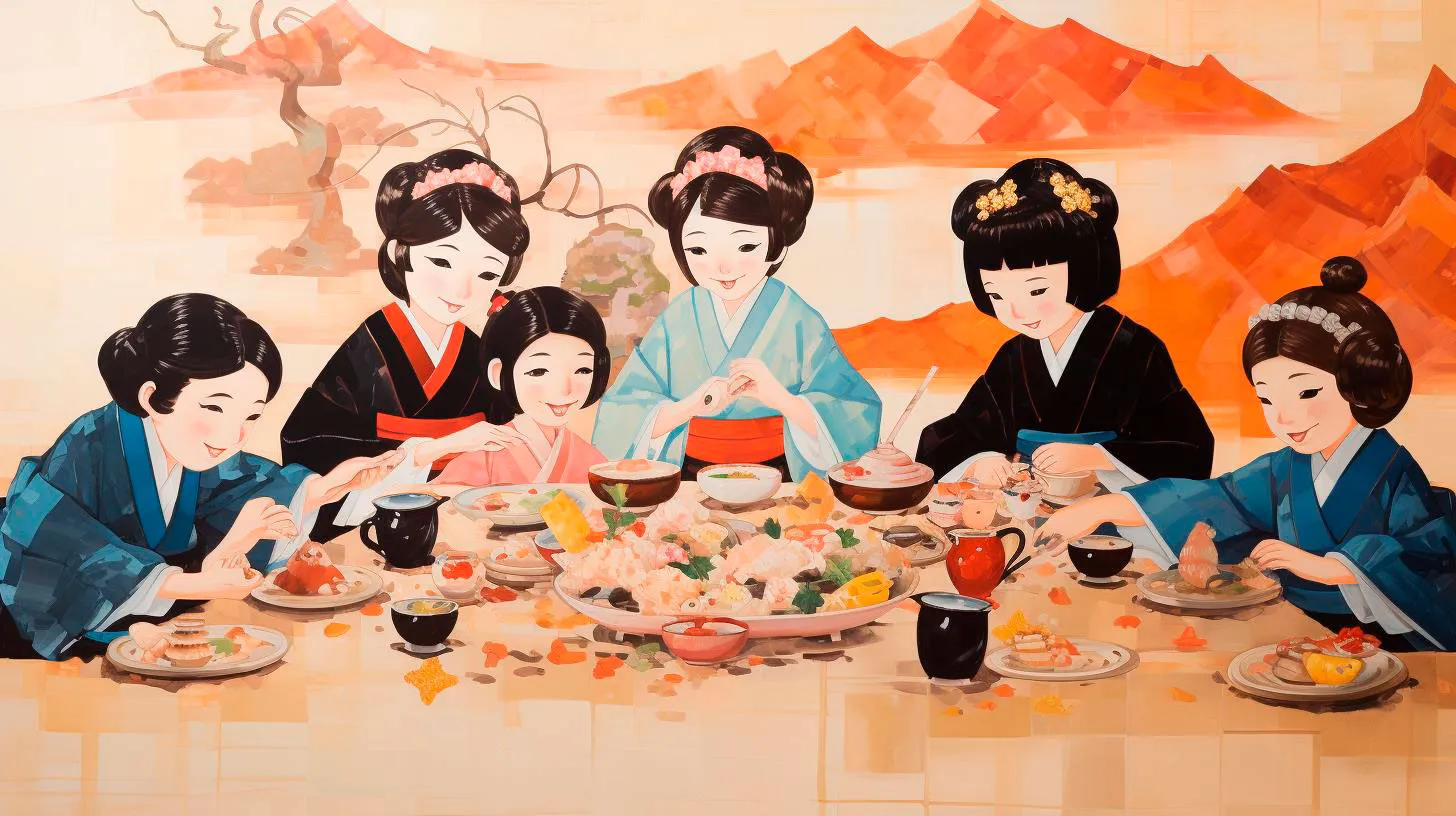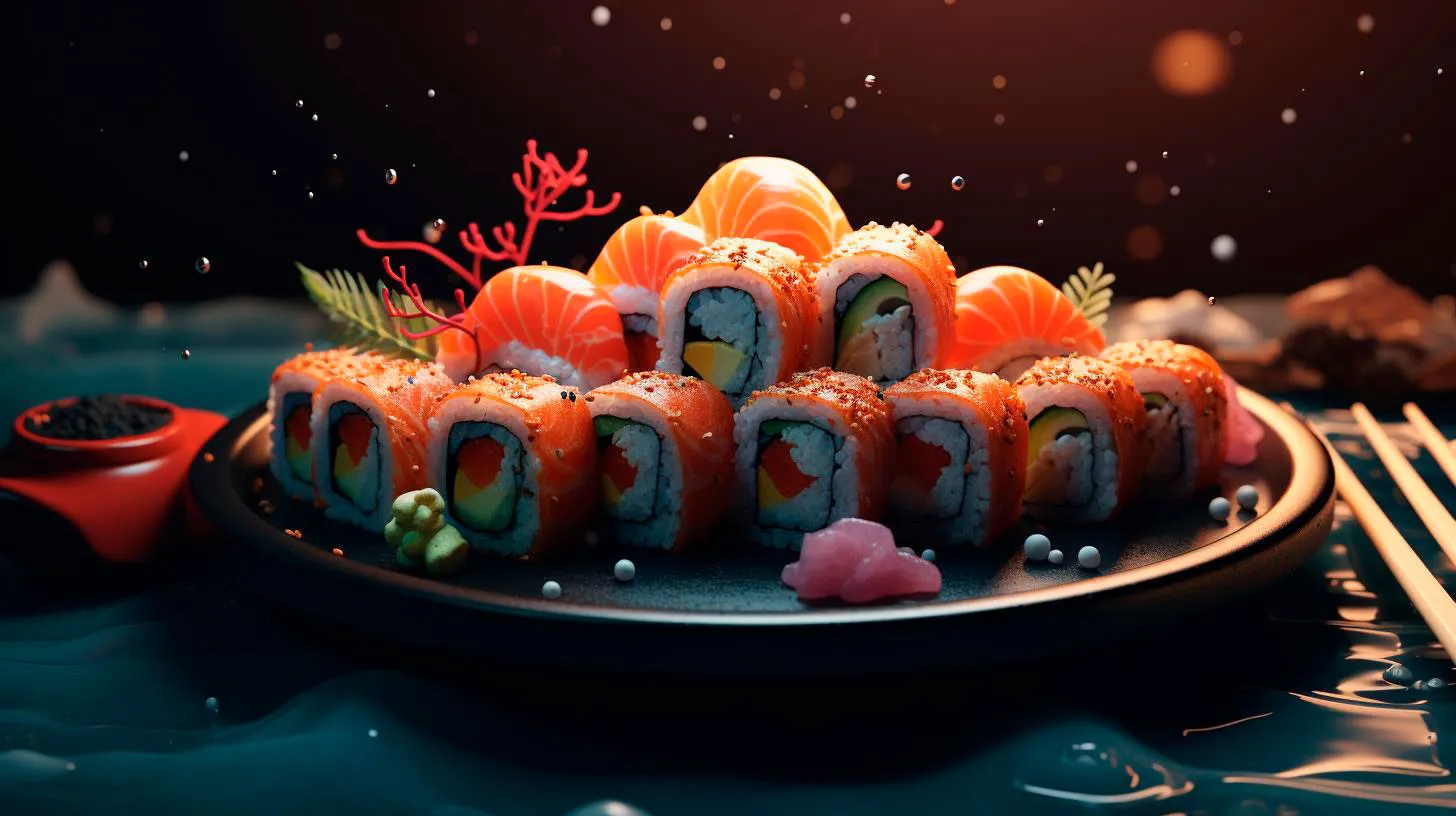Taste the Tradition: Unveiling the Cultural Exchange Encapsulated in Sushi
This exquisite delicacy not only tantalizes taste buds but also serves as a gateway to understanding the heritage and customs of Japan. In this article, we will delve into the fascinating journey of sushi, tracing its origins, exploring its various forms, and understanding the cultural exchange it represents.
A Glimpse into Sushi’s Origins
Sushi, a Japanese word that means “sour-tasting,” originated in Southeast Asia as a sour fermented fish dish. It wasn’t until the 8th century in Japan that sushi began evolving into the culinary masterpiece we know today. Sushi’s transformation was driven by the introduction of rice vinegar, which added a distinct flavor and helped preserve the fish for longer periods.
As time went on, sushi gradually became a part of Japanese culture, with different regions putting their own spin on the dish. Kyoto, for example, developed oshi-zushi, a style where sushi is pressed into wooden molds, creating visually stunning rectangular pieces. In contrast, Osaka’s contribution was battera, a box-shaped sushi made with mackerel. Every variation of sushi carries a unique story and pays homage to the traditions of its place of origin.
The Advent of Sushi Nigiri
Sushi nigiri, the most recognizable form of sushi, came into existence during the 19th century in Edo, now known as Tokyo. This innovation is attributed to Hanaya Yohei, a sushi chef who revolutionized the way sushi was made and served. Nigiri, meaning “hand-pressed,” involves molding a small mound of vinegared rice with an assortment of savory toppings, such as fish, seafood, or even vegetables.
The simplicity of nigiri allows the flavors to take center stage, and the delicate balance of rice, fish, and wasabi creates a harmonious symphony of taste. The bite-sized nature of nigiri also makes it the perfect vessel for sampling different flavors in one sitting, a characteristic that sushi aficionados cherish.
Sushi’s Cultural Exchange
Sushi’s journey from Southeast Asia to Japan was just the beginning of its global expedition. Today, sushi can be found in virtually every corner of the world, showcasing its adaptability and universal appeal. This global popularity has fostered a cultural exchange that transcends boundaries, contributing to the enrichment of various cuisines.
Here are some key takeaways that illustrate sushi’s cultural exchange:
- Western Influences: The introduction of sushi to the United States in the 1960s initiated a sushi revolution. Californian rolls, made with avocado and imitation crab, were invented to cater to American tastes. This fusion not only broadened sushi’s reach but also influenced sushi innovations in Japan itself.
- South American Creativity: In South America, specifically Brazil and Peru, sushi has undergone a unique transformation. Sushi rolls known as “Sushi Nikkei” emerged, combining traditional Japanese techniques with local ingredients like tropical fruits and seafood. This fusion cuisine has gained popularity worldwide and stands as a testament to cultural blending.
- Local Ingredients: Sushi made outside of Japan often incorporates regional elements, demonstrating how different cultures adopt and adapt traditional dishes. From smoked salmon in Scandinavia to cream cheese in the United States, these variations not only adapt to local palates but also highlight the versatility of sushi.
The Advantages Beyond Taste
While sushi is undeniably delicious, its advantages extend beyond mere gastronomy. Sushi is a healthy choice, packed with essential nutrients, lean proteins, and heart-healthy omega-3 fatty acids. Additionally, its minimal use of oils and reliance on fresh ingredients make it an ideal option for those striving for a balanced diet.
Furthermore, sushi’s unique presentation makes it a visual delight. The meticulously arranged rolls and precisely crafted nigiri offer a feast for the eyes and elevate the dining experience. Sushi is not just a meal; it is a work of art.
Key Takeaways
In conclusion, sushi serves as a conduit for cultural exchange, encapsulating the rich traditions and craftsmanship of Japan while embracing innovative twists from around the world. Its journey from a Southeast Asian fermented fish dish to a global phenomenon symbolizes the interconnectedness of our diverse world. So, whether you’re a sushi enthusiast or an aspiring culinary explorer, relishing sushi is not just an experience for your taste buds, but an invitation to understand and appreciate the cultural exchange it represents.
Sushi: A Tantalizing Exploration of Regional Varieties in Japan
However, what many people may not be aware of is that sushi is an incredibly diverse dish, with distinct regional variations found throughout Japan. In this article, we will embark on a tantalizing exploration of the regional varieties of sushi, delving into their unique characteristics, advantages, and key takeaways.
1. Nigiri Sushi: The Classic Bite-Sized Delight
Our sushi journey begins with the most well-known and widely available variety, Nigiri sushi. This classic style consists of a small hand-formed mound of rice topped with a slice of fresh fish or other seafood. Nigiri sushi is known for its simple yet elegant presentation and emphasizes the delicate flavors of the ingredients.
Key Takeaways:
- Nigiri sushi showcases the freshness and natural flavors of the fish or seafood.
- It is often served with a small amount of wasabi between the rice and fish for an added kick.
- Nigiri sushi is typically enjoyed with soy sauce and pickled ginger on the side.
2. Maki Sushi: The Artistic Rolls
If you’ve ever been to a Japanese restaurant, chances are you’ve encountered Maki sushi. This style features a variety of fillings wrapped in seaweed (nori) and rice, tightly rolled into a cylindrical shape. Maki sushi offers a wonderful canvas for creativity and presentation, allowing chefs to experiment with different ingredients and flavors.
Key Takeaways:
- Maki sushi allows for a plethora of ingredient combinations, catering to various tastes and preferences.
- The rolls are typically served with soy sauce and wasabi, and can be enjoyed in bite-sized pieces.
- Maki sushi can be made with different types of seaweed, such as roasted nori or soybean paper, for added variation.
3. Chirashi Sushi: The Scattered Treasure
Chirashi sushi, often referred to as “scattered sushi,” is a visually stunning dish that consists of a bowl of sushi rice topped with an assortment of sashimi, vegetables, and other garnishes. Unlike other sushi types, Chirashi sushi allows for a more customizable experience, with each bowl offering a unique assortment of flavors and textures.
Key Takeaways:
- Chirashi sushi offers a wide variety of toppings, showcasing the chef’s creativity and ability to balance flavors.
- It is often garnished with colorful ingredients like roe, shredded omelet, or seaweed for an enticing presentation.
- The dish is typically enjoyed by mixing the ingredients together, allowing the flavors to meld.
4. Inari Sushi: The Sweet Delicacy
Inari sushi is a sweet and savory delight that features a pocket of seasoned sushi rice encased in a pouch made from deep-fried tofu (aburaage). This type of sushi is known for its subtly sweet flavor and pleasing texture, making it a popular choice for those with a preference for milder options.
Key Takeaways:
- Inari sushi offers a unique blend of sweet and savory flavors.
- Made with tofu pouches, it provides a vegetarian-friendly alternative to fish-based sushi varieties.
- Inari sushi is often enjoyed as a standalone snack or as part of a larger sushi platter.
5. Temaki Sushi: The Hand-Rolled Indulgence
For those who prefer a hands-on approach, Temaki sushi is the perfect choice. This style involves a single large piece of seaweed (nori) filled with sushi rice, various fillings, and condiments, rolled into a cone shape. Temaki sushi provides a casual and interactive dining experience, inviting diners to assemble their own delectable creations.
Key Takeaways:
- Temaki sushi allows for customization, with each person having the freedom to choose their preferred fillings.
- It can be enjoyed as a standalone snack or as part of a sushi feast.
- Temaki sushi offers a fun and interactive dining experience, particularly enjoyed at home or in casual settings.
Conclusion
Sushi is a culinary journey that takes us through the diverse flavors and regional specialties of Japan. From the classic elegance of Nigiri sushi to the customizable delights of Chirashi sushi, each variety offers its own unique experience. By exploring these regional sushi varieties, we not only deepen our appreciation of Japanese cuisine but also embark on a delightful adventure for our taste buds.
Diving Deep into Sushi: Unraveling the Cultural Significance of Regional Varieties
While most people are familiar with popular sushi types like nigiri and maki, there is a world of regional sushi varieties waiting to be explored. Join us on a journey as we dive deep into the cultural significance of regional sushi and uncover the secrets behind their distinctive flavors.
1. Edomae-zushi – The Heart and Soul of Tokyo
Edomae-zushi, originating from Edo (now Tokyo), is where sushi as we know it today was born. Traditionally, this style of sushi was made using fish caught in the bays of Edo, offering a unique combination of flavors. The rice used in Edomae-zushi is seasoned with vinegar, giving it a tangy taste that complements the freshness of the fish. Key takeaways of Edomae-zushi include:
- Pristine ingredients sourced from the Tokyo Bay
- Vinegar-seasoned rice with a subtle tang
- Emphasis on simplicity and flavor of the fish
2. Kansai-style – A Kyoto Delicacy
In the ancient city of Kyoto, a different style of sushi emerged known as Kansai-style. What sets Kansai-style sushi apart is the use of mackerel as the main ingredient. The mackerel is marinated in a blend of vinegar, soy sauce, and mirin, giving it a rich umami flavor. Kansai-style sushi also features a variety of colorful toppings, creating an exquisite visual appeal. Key features of Kansai-style sushi include:
- Flavorful marinated mackerel as the star ingredient
- A balance of sweet, salty, and tangy flavors
- Visually appealing with vibrant toppings
3. Hakata-style – A Taste of Kyushu
From the southern island of Kyushu comes Hakata-style sushi, a regional variety that showcases the unique flavors of the region. Hakata-style sushi features toppings like mentaiko (marinated cod roe) and ikura (salmon roe), which add a burst of briny flavors to the sushi. The rice used in Hakata-style sushi is seasoned with soy sauce, enhancing its savory taste. Key highlights of Hakata-style sushi are:
- Use of marinated roe toppings for a rich burst of flavor
- Soy sauce-seasoned rice for a savory touch
- A regional specialty that represents the flavors of Kyushu
4. Chirashizushi – A Colorful Feast
Chirashizushi, meaning “scattered sushi,” is a celebratory dish that showcases an array of colorful ingredients. This style of sushi is commonly enjoyed during special occasions or festivals. Chirashizushi features a bed of vinegared rice topped with a variety of ingredients such as fresh seafood, vegetables, and pickles. It is a visually stunning dish that offers a diverse range of flavors and textures. Key features of Chirashizushi include:
- A vibrant assortment of ingredients
- Customizable according to personal preferences
- Delightful combination of flavors and textures
5. Oshizushi – The Art of Pressed Sushi
Hailing from the Kansai region, oshizushi is a style of sushi that is pressed into a wooden mold called an oshibako. This technique creates square-shaped sushi pieces with distinct layers. Oshizushi is known for its beautiful appearance and well-balanced flavors. The toppings can vary, but common choices include fish, vegetables, and even tofu. Key takeaways of oshizushi are:
- Artful presentation with distinct layers
- Variety of toppings that cater to different preferences
- A traditional technique that highlights the craftsmanship behind sushi-making
Bringing It All Together
Sushi is not just a meal; it is an experience that reflects the rich cultural heritage of Japan. Each regional sushi variety carries its own unique story and flavors, providing a glimpse into the diverse culinary landscape of the country. By exploring the cultural significance of sushi, we not only satisfy our taste buds but also gain a deeper appreciation for the artistry and craftsmanship involved in this beloved cuisine.
So, the next time you savor a piece of sushi, take a moment to unravel its origin and enjoy the cultural journey it takes you on.
From Tradition to Trend: The Rising Popularity of Sushi Symbolism
In this article, we delve into the rising popularity of sushi symbolism and uncover the secrets behind its enduring appeal.
Understanding Sushi Symbolism
Sushi is more than just a dish; it is a symbol of Japanese culture, tradition, and heritage. Each element of a sushi meal carries a profound meaning that speaks to the values and aesthetics deeply rooted in Japanese society. To truly appreciate the symbolism of sushi, let’s look at some key aspects:
1. The Rice: Unity and Harmony
The rice used in sushi is more than a mere ingredient; it symbolizes unity and harmony. Just as the grains of rice come together to create a cohesive sushi roll, sushi represents the importance of unity in relationships, be it between friends, family, or even nations.
2. The Fish: Prosperity and Abundance
The choice of fish in sushi is not arbitrary. Different types of fish carry specific symbolism. For instance, tuna represents strength and endurance, while salmon symbolizes wealth and abundance. By consuming these fish, individuals are believed to attract similar qualities in their own lives.
3. The Wasabi: Spiritual Cleansing
Wasabi, the pungent green condiment served alongside sushi, holds a significant place in Japanese culture. It symbolizes purity and spiritual cleansing, as it is believed to cleanse the palate and ward off evil spirits. Additionally, its spicy flavor is said to awaken the senses and enhance overall well-being.
The Allure of Sushi Symbolism
The popularity of sushi symbolism goes beyond its cultural relevance. Here are some reasons why sushi has become a trendsetter in the culinary world:
1. Aesthetic Appeal
Sushi’s visually pleasing presentation is a feast for the eyes. Its vibrant colors, delicate arrangements, and meticulous craftsmanship make it one of the most visually appealing culinary experiences. Instagram-worthy sushi platters have become a social media sensation, drawing attention from food enthusiasts worldwide.
2. Health Benefits
Sushi’s rise to prominence can be attributed, in part, to its perceived health benefits. With a focus on fresh ingredients and minimal processing, sushi is often considered a nutritious choice. Fish, a key component of sushi, is rich in omega-3 fatty acids, known for their heart-healthy properties. Additionally, sushi is often accompanied by nutrient-rich seaweed, which adds to its nutritional value.
3. Increasing Diversity
The popularity of sushi has led to the diversification of its flavors and ingredients. Sushi chefs across the globe have embraced local ingredients and techniques to create fusion sushi, combining traditional Japanese flavors with local cuisines. This diversity has expanded the appeal of sushi, catering to a broader range of taste preferences.
The Key Takeaways
As sushi continues to captivate the world, it is important to recognize the underlying symbolism and cultural significance embedded within this ancient dish. Here are the key takeaways:
- Sushi is not just food; it is a representation of unity, harmony, prosperity, and spiritual cleansing.
- The aesthetic appeal of sushi, coupled with its health benefits, has contributed to its widespread popularity.
- The diversification of sushi flavors and techniques has made it more accessible and appealing to a wider audience.
Whether you enjoy sushi for its symbolic meaning, its visual allure, or its health benefits, there is no denying its transformation from a traditional delicacy to a global culinary trend. So, the next time you savor a delectable sushi roll, remember the rich symbolism and culture it embodies.



